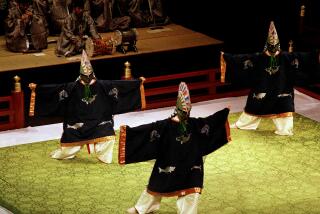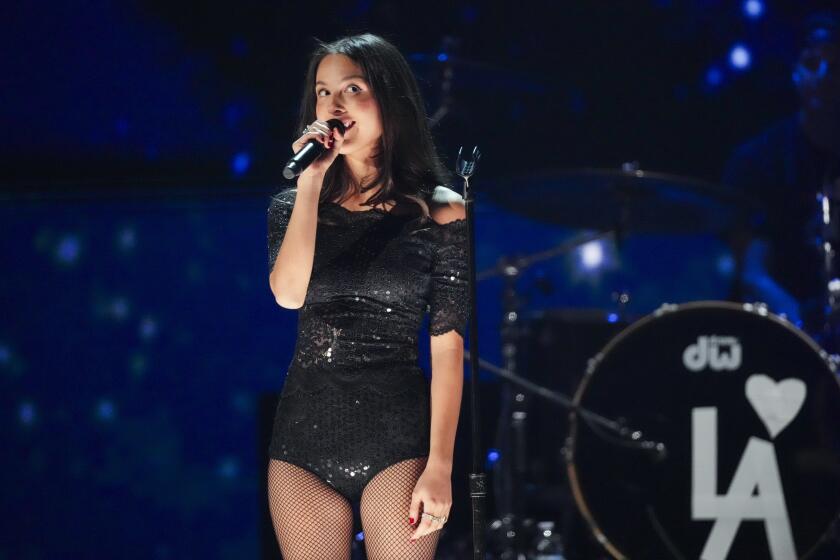SWING IS THE THING AT CLASSIC JAZZ FESTIVAL
- Share via
The Los Angeles Classic Jazz Festival, which offered a torrent of sound from Friday afternoon through Monday afternoon of Labor Day weekend, has broadened its base and its audience.
Chuck Conklin, the festival’s founding director, said Sunday night that paid admissions will be about 25% over 1986 figures and that total attendance for the four days will hit 20,000. The principal venue, the Airport Marriott, was sold out by mid-July and a second hotel, the Airport Hilton, added. There was music simultaneously in 10 ballrooms, three at the Hilton.
In its initial run four years ago, the festival majored heavily in Dixieland Revisited--classical closely defined as traditional. A wide choice of groups wandered down yonder in New Orleans, re-creating a particular past over a spectrum from ricky-tick in blazers to work more thoughtful and interpretive.
Traditional was still out in force and well attended this time, including some international groups: the East Berlin All-Stars, the Dutch Swing College Band from The Hague, the Paco Gatsby Band from Guatemala and Harry Gold’s Pieces of Eight from London.
Among the domestics, very popular, were the dynamic blues singer Banu Gibson and her New Orleans Hot Jazz Orchestra, the Black Eagle Band from Boston, Conrad Janis’ raucous Beverly Hills Unlisted Jazz Band, and the Golden Eagle Band from Pasadena, with its fine vocalist, Chris Norris.
But the high points of the weekend were two long Sunday night concerts by the Abe Most 17-piece big band in a tribute to Benny Goodman, with Goodman’s longtime vocalist Martha Tilton. Although the band had had only one full rehearsal, it played the Dick Cary arrangements, emulating the Fletcher Henderson and Eddie Sauter originals, with dazzling precision and fine, fresh solo work by the swift and lyrical Most, Cary himself and Dick Cathcart among the trumpets, Les Robinson on alto sax, Sam Most on flute.
The audiences are surprisingly stingy with standing ovations (a welcome change in Los Angeles). But at the Hilton concert, played to a standing-room-only crowd in the 1,600-seat grand ballroom, there was an ovation for Tilton, who sounded wonderfully young-voiced and energetic a half-century after her days with the band.
There was a second ovation for the band itself as it finished with a powerful “Sing Sing Sing” with Jack Sperling at the drums.
Another big band, the Capp-Pierce Juggernaut, with Nat Pierce at the piano, also drew large, appreciative audiences for its mobile and massive sounds.
A complaint from earlier years that the festival was largely a white affair has been tended to.
A repeat from 1986 was the late Joe Liggins’ Honeydrippers. Other guest artists included pianists Sir Charles Thompson and Chester Lane, trumpeter Clora Bryant and her Swi-Bop Ensemble, the young New Orleans players Wendell Brunious on trumpet and Michael White on clarinet, and Chris Kelly’s Black and White New Orleans Jazz Band with tailgate trombonist John Ewing.
The big bands made the case for the band itself as a kind of single, unified jazz instrument, in the Ellington-Basie-Goodman-Shaw tradition. But the weekend as a whole, especially in the work of the small and shifting ensembles, reaffirmed quite spectacularly that great jazz is finally the creation of gifted individuals.
Saturday afternoon on what is customarily the Marriott’s subterranean parking ramp, the fleet-fingered Milwaukee clarinetist Chuck Hedges and pianist Johnny Varro teamed on a lightning version of “After You’ve Gone” that was at once as lyrical and inexhaustibly inventive as anything done all weekend. It drew the first of the weekend’s infrequent roaring, standing ovations.
The number was part of a set featuring Wild Bill Davison, the legendary cornetist now in his 80s but playing like a rascally child.
The group’s drummer was one of the festival’s outstanding invitees, the veteran Buzzy Drootin, who used to play intermission duos with Varro at Eddie Condon’s in the heyday of that famous oasis. In a later set led by Varro, the pianist took a long quick-tempo solo on Cole Porter’s “I Love You,” with Drootin performing small symphonic miracles with wire brushes.
Tasty is an overworked word in musical matters, but Drootin, a dapper gent with a brisk mustache, is a drummer of exquisite taste. At home in Boston, he leads a group he calls Endangered Species, a not irrelevant commentary on his own kind of melodic drumming, which combines a sure beat with a restraint that reminds you volume isn’t everything, and that in drumming, as in much else, less may well be more.
The festival, like Cannes, induces anxiety because at any moment you know there are eight or nine other things you could be seeing and hearing. I wouldn’t have missed, but almost did, the Jean Kittrell Incredibles, a piano, banjo and sousaphone trio that drew hundreds to the Marriott Grand Ballroom. Kittrell on piano sang some hefty blues, and the lovely legato passages David (Red) Lehr achieved on the sousaphone are nothing like oompah.
The Abalone Stompers and Seabreeze both featured Jackie Coon, the master of the graceful fluegelhorn whose mellow figures seem to flow out of some lost time when Bix Beiderbecke was still among us. Seabreeze, with charts by Dick Cary, recalls the Ellington band in its subtle, swinging voicings.
It is an exhausting outing for the players. On Saturday, Coon was booked with successive ensembles for six straight hours and three more after a supper break, for example. But when a group is going well, it becomes one of the festival’s great pleasures to see the pleasure the musicians take in each other’s solos, grinning, nodding, pointing and miming applause. It was a classic weekend, but only partly traditional.
More to Read
The biggest entertainment stories
Get our big stories about Hollywood, film, television, music, arts, culture and more right in your inbox as soon as they publish.
You may occasionally receive promotional content from the Los Angeles Times.










